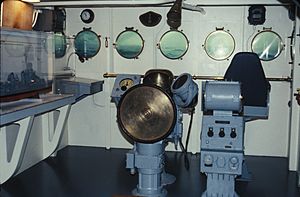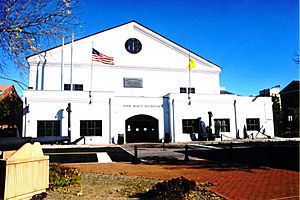National Museum of the United States Navy facts for kids

U.S. Navy Museum logo
|
|
| Lua error in Module:Location_map at line 420: attempt to index field 'wikibase' (a nil value). | |
| Established | 1961 |
|---|---|
| Location | 736 Sicard St SE, Washington, DC 20374 |
| Type | |
| Public transit access | |
The National Museum of the United States Navy, also known as the U.S. Navy Museum, is the main museum of the United States Navy. It is located in Washington, D.C. at the historic Washington Navy Yard. The museum is housed in a building that used to be a workshop for making parts for naval guns.
This museum is one of ten official Navy museums across the country. It is part of the Naval History & Heritage Command, which is the official group that looks after the Navy's history.
Contents
What the Museum Does
The U.S. Navy Museum collects, protects, and shows historic naval items and art. Its goal is to teach and inspire both Navy members and the public. It helps everyone learn about the Navy's important role in history.
A Look at the Museum's History
The U.S. Navy Museum first opened its doors to visitors in 1963. It was created in 1961. Among the many Navy museums, this one is special because it tells the whole story of U.S. naval history. The museum has exhibits that honor Navy heroes and battles from wartime. It also shows the Navy's work during peacetime, like exploring, diplomacy, space flight, and helping people.
For over 60 years, the U.S. Navy Museum has been a leading place for learning. The tradition of collecting Navy items started way back in the early 1800s. The very first item was a French gun captured during a conflict with France. As the Navy grew and fought more battles, its collection of artifacts also grew.
In 1865, a special building opened to display these items. It was called the Museum of Naval Relics and Weapons. This was one of America's first federal museums. Visitors could see amazing things, like a gun from the Spanish explorer Hernan Cortés. They could also see a part of the ship Kearsarge that had a shell from a famous battle.
Over the years, the museum's collection moved a few times. In 1961, Admiral Arleigh Burke helped create the current museum in Building 76. He wanted a naval history museum that could compare to the best in Europe. Today, the U.S. Navy Museum continues his vision. It shares the Navy's history and traditions with people from all over the world.
The museum is the only one that covers the U.S. Navy's history from its start to today. You can see parts of the USS Constitution and the Trieste, which is a submersible that went deeper than any other. You can also see the uniform of famous Fleet Admiral Chester W. Nimitz.
The museum welcomes many visitors each year. It is free to enter and offers programs for everyone. The building is also easy to access for people with disabilities.
The National Museum of the United States Navy is open to the public. Because the museum is on an active military base, visitors need to show a valid government ID. If you don't have one, you can get a day pass at the visitors' center. When you enter, you can see a part of the USS Constitution and a statue of Boatswain's Mate Charles W. Riggin. This statue was made from melted dimes.
Willard Park
Willard Park is located between the museum and the waterfront. It is named after Admiral Arthur L. Willard. The park displays many old iron guns. You can also see a propeller from the battleship USS South Dakota (BB-57). There's a 6-inch gun saved from the battleship USS Maine. Another interesting item is a special sphere from the Alvin undersea vehicle. The park also has a Swift Boat called PCF-1 and a large 14-inch/50-caliber railway gun from World War I.
Main Exhibits
This large room is all about the history of American submarines. It has real working periscopes, computers used for targeting, and battle flags.
The American Revolution and the French Alliance
Learn about the U.S. Navy's early, tough beginnings near the museum's entrance. This exhibit includes a video, old weapons, and pictures of early American Navy heroes.
The Forgotten Wars of the 1800s
This exhibit shows items from the Quasi-War with France, the First Barbary War, the Second Barbary War, the War of 1812, and the Mexican–American War. A main part of this exhibit is a copy of the gun deck from USS Constitution.
Civil War
The Civil War exhibit shows the types of warships and gear used by sailors. You can see models of famous ironclad ships like USS Monitor and CSS Virginia. Models of the CSS Alabama and the USS Kearsarge (1861) are also on display.
Spanish–American War
This exhibit tells the story of the battleship USS Maine (ACR-1) and how its loss led to public anger. It also shows how the United States became a global power. You can see weapons, items from home, and a model of the unique USS Vesuvius (1888). Admiral George Dewey's uniform is also here.
Polar Exploration
The story of Admiral Richard Byrd's 1928 trip to the South Pole is told through photos and equipment. You can also see items from other trips to the poles.
Learning how to navigate at sea has always been important. This small exhibit explains different navigation methods and tools. The room is full of old maps, clocks, and weather equipment.
This exhibit covers the U.S. Navy's short time in the First World War. It explains the dangerous job of hunting submarines. You can see models of warships, a captured German flag, and videos of a U.S. Navy railway gun in action.
This is the largest part of the museum. It is divided into three sections.
- The Atlantic Theater. This part shows how convoys were protected and how the German Enigma code was broken. It also highlights the role of the Merchant Marine. You can see weapons and equipment used by both sides. There are cannons, rifles, and pistols. You can also see a high-altitude flying suit and a diving log from the U-505 submarine.
- The Home Front. This exhibit looks like an old storefront and has a small theater showing a film from the World War II era. It is decorated with patriotic posters and personal items. It also explains the role of WAVES, women who served in the Navy.
- The Pacific Theater. This area is a big part of the World War II section. It has a full-size copy of the bridge from the destroyer USS Fletcher. There are also four gun batteries, an FG-1D Corsair plane, a Japanese MXY7 Ohka kamikaze aircraft, and two atomic bomb casings. You can also see large models of the carrier USS Leyte (CV-32) and the battleship USS Missouri (BB-63).
Uniforms, equipment, videos, and other items help bring the Korean War into focus. You can see captured Soviet weapons, models of aircraft and warships, and a piece of the Inchon seawall.
Other Interesting Exhibits

The deep-sea vehicle Trieste is a highlight of the Undersea Exploration exhibit. There is also a small exhibit about the Steel Navy (1883–1909). Another exhibit covers the Battle of Trafalgar and includes a short film about naval artillery.
Future Plans
In October 2020, the Secretary of the Navy announced plans for a new National Museum of the United States Navy. This new museum will be built near the Washington Navy Yard, but outside its security area. This means visitors will be able to enter without needing special IDs or passes. Construction and setup are planned for around 2025.
There are nine other official Navy museums:
- Hampton Roads Naval Museum – Norfolk, VA
- National Museum of the American Sailor – Naval Station Great Lakes, IL
- National Naval Aviation Museum – Pensacola, FL
- Naval Undersea Museum – Keyport, WA
- Naval War College Museum – Newport, RI
- Puget Sound Navy Museum – Bremerton, WA
- Submarine Force Museum and Historic Ship Nautilus – Groton, CT
- U.S. Naval Academy Museum – Annapolis, MD
- U.S. Navy Seabee Museum – Port Hueneme, CA
See also
 In Spanish: Museo Nacional de la Armada de los Estados Unidos para niños
In Spanish: Museo Nacional de la Armada de los Estados Unidos para niños
- Category: United States Navy museums
- Category: Marine Corps museums in the United States
- National Museum of the United States Air Force
- National Museum of the United States Army
Aircraft Carrier Museums
- USS Hornet Museum; Alameda, California – USS Hornet (CV-12)
- Intrepid Sea, Air & Space Museum; New York City – USS Intrepid (CV-11)
- USS Lexington Museum on the Bay; Corpus Christi, Texas – USS Lexington (CV-16)
- USS Midway Museum; San Diego, California – USS Midway (CV-41)
- Patriots Point; Charleston, South Carolina – USS Yorktown (CV-10)
Battleship Museums
- Battleship Memorial Park; Mobile, Alabama – USS Alabama (BB-60)
- Battleship USS Iowa Museum; San Pedro, California - USS Iowa (BB-61)
- Battleship Cove; Fall River, Massachusetts – USS Massachusetts (BB-59)
- Battleship Missouri Memorial; Pearl Harbor, Hawaii – USS Missouri (BB-63)
- Battleship New Jersey Museum and Memorial; Camden, New Jersey – USS New Jersey (BB-62)
- USS North Carolina Battleship Memorial; Wilmington, North Carolina – USS North Carolina (BB-55)
- San Jacinto State Park; LaPorte, Texas – USS Texas (BB-35)
- Nauticus Maritime Center; Norfolk, Virginia – USS Wisconsin (BB-64)
- See also: USS Arizona Memorial, USS Maine (1889)#Memorials, USS South Dakota (BB-57)#Post-war
Other Museums
- Buffalo and Erie County Naval & Military Park – USS Little Rock, USS The Sullivans, USS Croaker
- National Civil War Naval Museum at Port Columbus
- National Museum of the Pacific War (Admiral Nimitz State Historic Site)
- Pearl Harbor National Memorial
- Soldiers and Sailors National Military Museum and Memorial
- United States Naval Shipbuilding Museum – USS Salem (CA-139) (heavy cruiser)
- USS Kidd Veterans Museum, Baton Rouge, Louisiana – USS Kidd (DD-661) (destroyer)
- USS Becuna (SS-319) (submarine)
- USS Cod (SS-224) (submarine)
- USS Edson (DD-946) (destroyer)
- USS Nautilus (SSN-571) (submarine) – see Submarine Force Museum
- USS Olympia (C-6) (cruiser)
- USS Orleck (DD-886) (destroyer) - Jacksonville, Florida
- USS Requin (SS-481) (submarine)
- USS Turner Joy (DD-951) (destroyer)
- USS Slater (DE-766) (Destroyer escort)
- War in the Pacific National Historical Park
- Wings of Freedom Aviation Museum
- Wisconsin Maritime Museum – USS Cobia (SS-245) (submarine)
- Category:Naval museums in the United States
- List of museum ships



